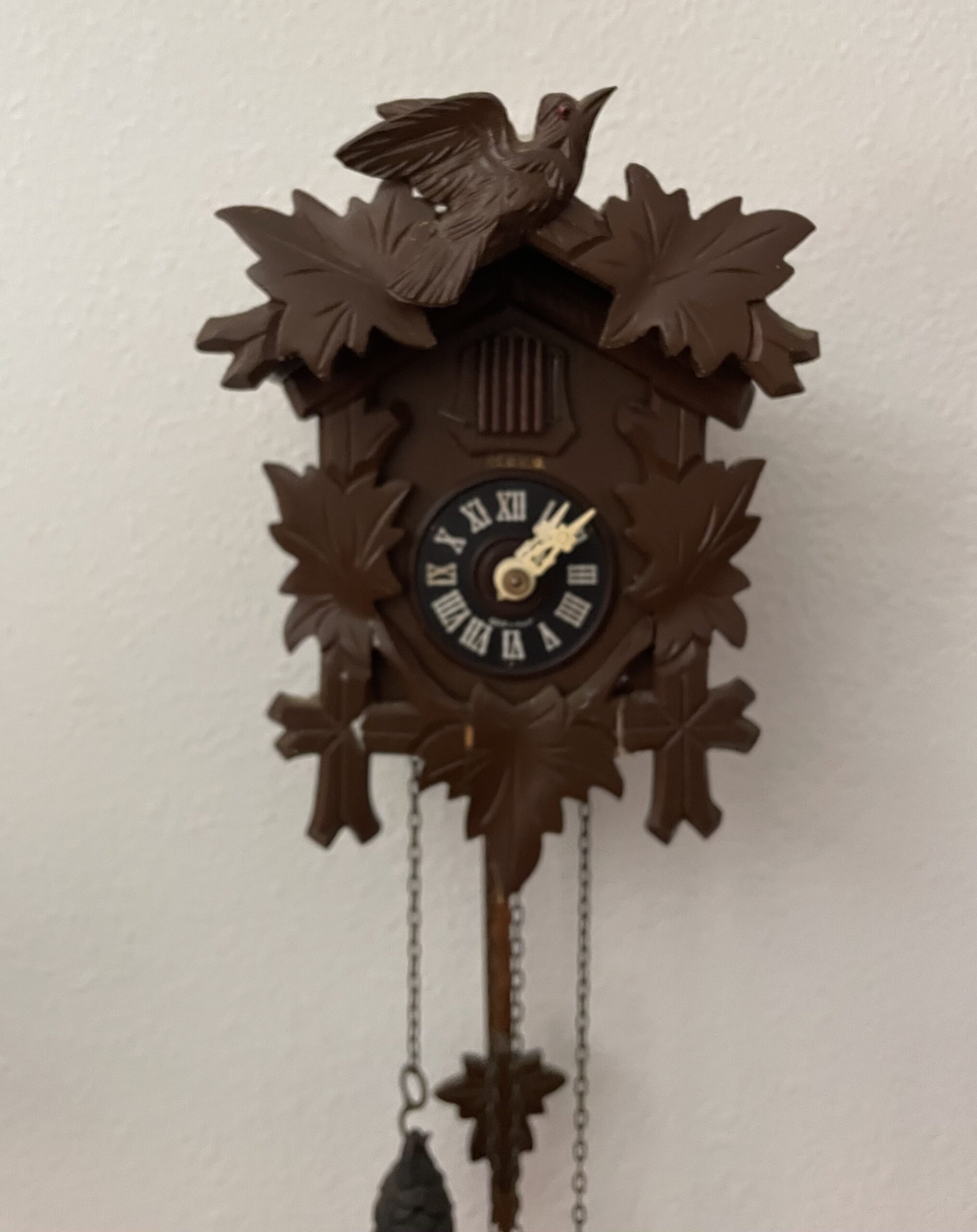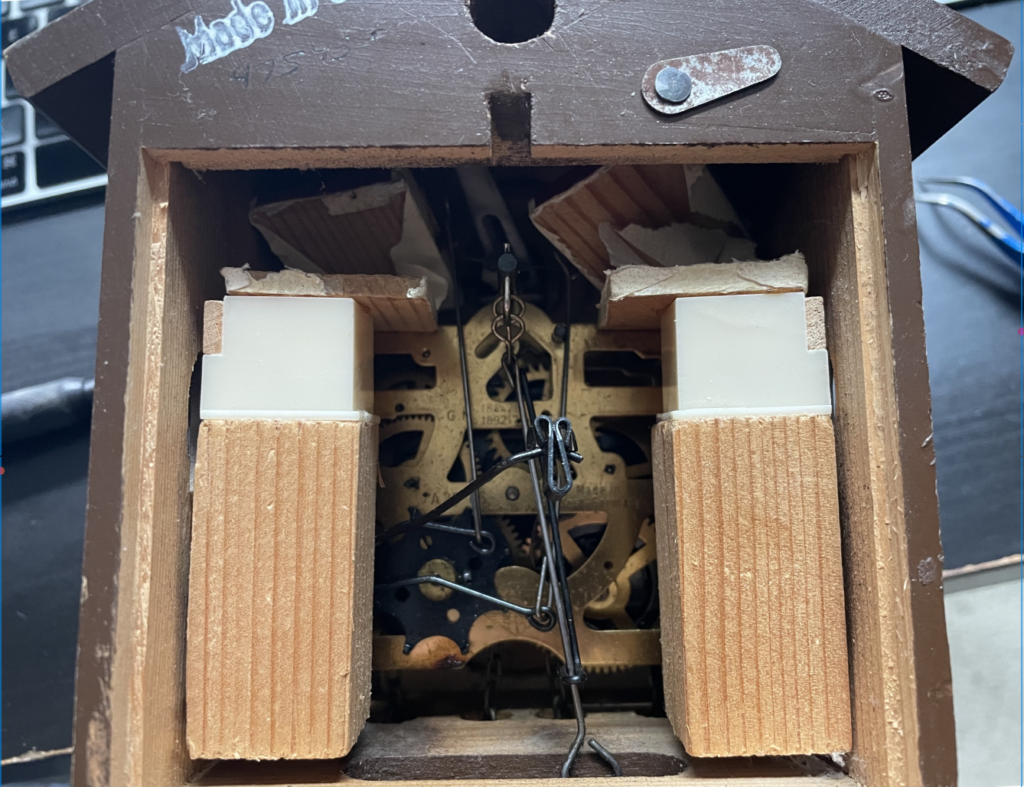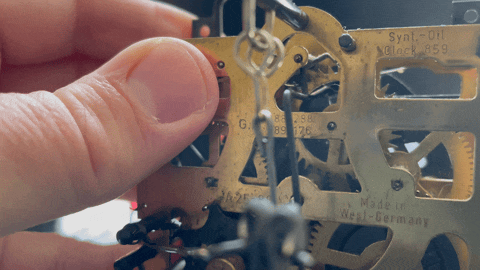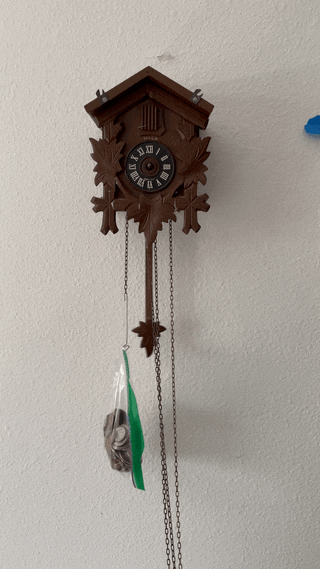
I’ve had a mild interest in Cuckoo clocks for as long as I can remember. Any kind of automata has captured my attention since I was kid. We haven’t ever owned one, but I’m interested in the mechanical nature of them, and how interesting it is that people could make these literally hundreds of years ago. It’s a real testament to engineering.
We received a broken Cuckoo clock as a gift, and it ended up in a pile on our table until about a week ago. I picked it up and wondered if I could fix it.
This really was a journey. I had no idea how cuckcoo clocks worked internally. Popping it open exposed an odd variety of items but no real clarity yet on how it worked.

Jammed chains
Once I got to the clock mechanism, something was obviously wrong and it wasn’t terribly hard to see even if I was unfamiliar with gravity driven clock mechanisms. One of the chains was not in the groove where it was supposed to be. It was jammed between the frame and a couple of gears. I don’t know how it got that way, but some finagling got it free. After that I could pull the chain and make the hands spin, and pulling the chain the other direction reset the chain’s position.
That was one thing solved (sort of.)
How does a Cuckoo clock make it’s call?
I unscrewed and pulled out the two blocks on the back. Clearly something was torn and worn out. A little bit of poking around online got me my first clue. I was reading about cuckoo clock repair and came across the word bellows. Reading that and seeing a picture suddenly struck me – I picked up the block and blew into the hole on it and there it was, a whistle! It made me giggle maniacally – having discovered the secret to the cuckoo’s call.
One thing that surprised me the deeper I got into it was just how simple the mechanism was. Some folded paper, a couple of pieces of wood, and an angled slot for a whistle. Putting aside the complexity of the clock mechanism for a moment, this was something I could make at home! With my rudimentary wood-working skills.
Fixing the bellows
Traditionally, bellows are made with very thin pieces of leather. I tried buying some leather from a craft store, but it was much too thick and I was too impatient. The other material that is frequently used is Tyvek paper. You may have seen this stuff wrapping houses to serve as a moisture barrier. The other place it’s very often found is in shipping materials. The United States Postal Service has large shipping envelopes made of this stuff. It’s a great material because it’s easy to cut, but hard to tear.
I had mixed success making these. My first attempts using hot glue generally worked, but if I accidentally touched the paper with the tip of the glue gun it melted a hole in it immediately. I gave up on hot glue and switched to E6000 adhesive. The E6000 worked great, but was imperfect. In the video above you can here a ‘sticking’ sound when I think some extra adhesive interrupts the closing of the bellows. I’ve had to pull this one apart again and give it another shot.
No time like the present
One problem I faced was the clock not actually keeping time. Putting the pendulum on sometimes helped, but eventually I noticed that the escape wheel (that’s the little toothed gear that counts seconds) wasn’t actually engaging with the verge (The little rocker moves it back and forth). It was just moving its two points between the same teeth. A little back and forth with an AI tool suggested that there might be an alignment problem. Sure enough, there were a couple of gears that become dislodged (probably along with whatever got the chain out of place). Once I got that corrected, the escapement started moving as expected.

This was working when I was pulling on the chain, but I needed the clock to do it automatically. The way that gravity driven clocks work is by having the chain pull on a gear at a constant rate and the escapement manages the timing. This is dependent on the correct weight on the end of a chain. Too light and the pendulum won’t keep swinging. Too heavy and you put stress on the mechanism and wear it down prematurely.
The proper weights usually come with the clock. Most often they are cast iron pinecones. Not having such a pinecone, I opted for a cheap (ha-ha) and easy solution: A bag of money.

I did this is just a temporary solution. It was easy to add or subtract weight from it to find the right pull. There are plenty of sources for finding a replacement weight online.
Breaking news: As I was typing this, my wife walked in and asked why I hadn’t used the weights. I told her I didn’t know where they were, to which she responded “Aren’t they right here?” and proceeded to pull a ziplock bag off of the table where the clock had been and present me two cuckoo clock weights. To my surprise, they are 275g, not 320g as I thought they’d be. I’m glad I didn’t end up ordering the wrong ones!
I’ve had a bit of mixed success with the weights. Having wound the clock once, I messed up the position or something and it ran out of momentum to keep counting time. The short version is this: the clock has to be level. If the weight is pulling the wrong way, it’ll mess up the timing, which will push the pendulum out of its even swing.
Fixing the bellows (again)
The bellows I fixed didn’t behave the way I wanted them to. I expected a cleaner sound, and it seemed the best I got was a muted tone when rapidly moving it. This was in part caused by the seal on the paper not being complete. Air was escaping from the bellows, but not through the whistle. Also, I found that the paper from the USPS envelope was not as flexible as I hoped.
I tried again, this time using bellows paper I purchased online, and used wood glue to bond to the wood. I had to do a fair bit of sanding to get the pieces’ surfaces clean. There was also a comedy of errors associated with putting the pieces on wrong, or backwards. Suffice to say, I got it all fixed.
Putting it all back together
There were a few issues putting back together the bird – it’s mounting had a cracked. I tried to fix it with E6000 and Epoxy, and ultimately found the most effect adhesive was simple superglue. Also among the issues putting it back together, I forgot to thread the chain on to its indexing wheel. A lot of these small mistakes were a matter of working within a confined space.
So, it works! I find when the hour strikes the movement seems to be struggling. If you pull on the weight it’s okay. I think this is because the movement needs to be oiled. The chain on the bird’s size is difficult to pull as well.
This was an unexpected project. I didn’t think I would get into it as far as I have, and since starting this I’ve gotten two more cuckoo clocks. All 3 are different from one another. I’m looking forward to digging into the next one – after a break.